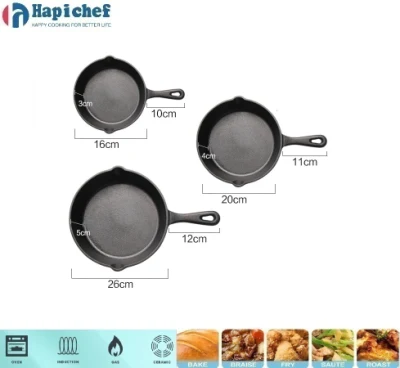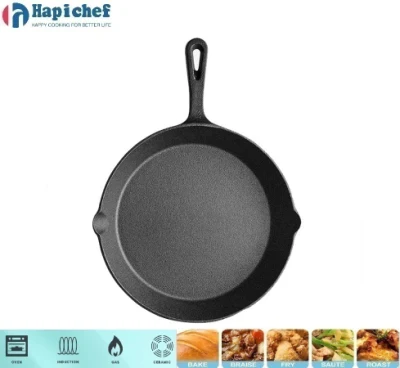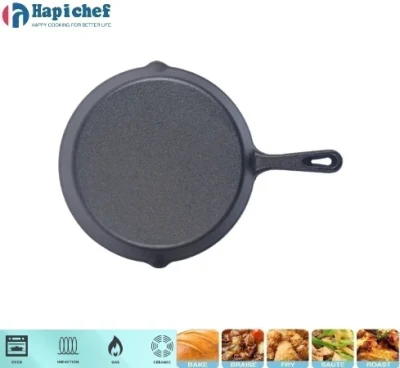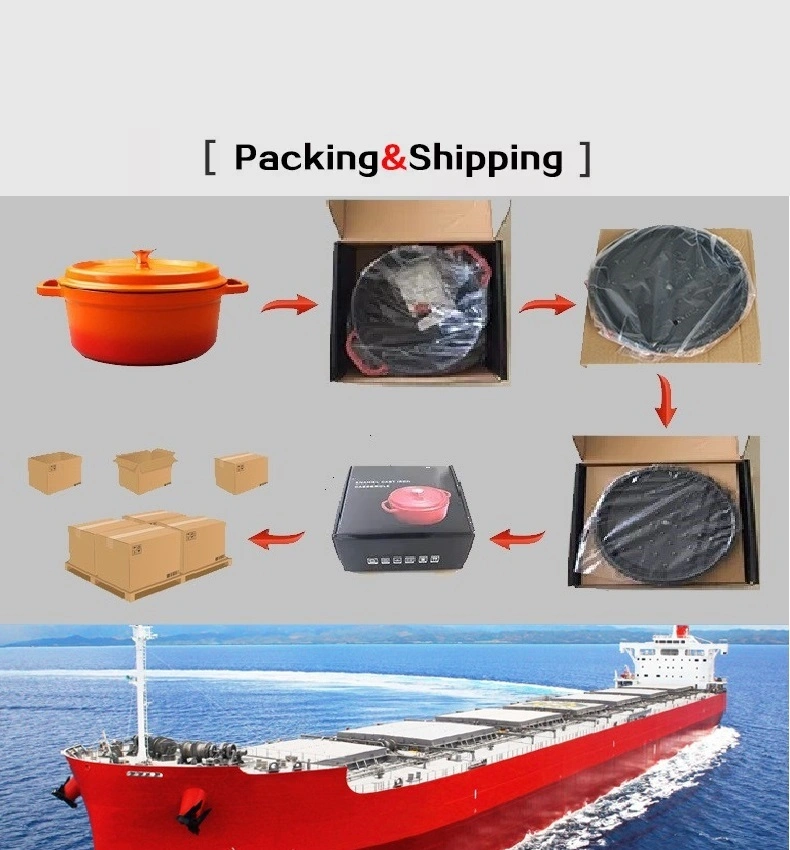Big Cast Iron Pan: Heavy-Duty Skillet for Perfect Cooking
The Enduring Appeal and Technical Superiority of big cast iron pan in Professional Kitchens
In the dynamic world of professional culinary arts, the choice of cookware significantly impacts efficiency, food quality, and operational longevity. Among the myriad options, the big cast iron pan stands out for its unparalleled durability, exceptional heat retention, and versatile cooking capabilities. It is not merely a piece of kitchen equipment but an investment that offers consistent performance and contributes to superior culinary outcomes. From searing to braising, the inherent properties of cast iron make it an indispensable tool for chefs and catering services requiring robust and reliable solutions. This comprehensive guide delves into the technical aspects, manufacturing excellence, and practical benefits that position big cast iron skillet as a cornerstone of high-performance kitchens globally.
The demand for these substantial cooking vessels reflects a growing trend towards traditional materials known for their sustainable attributes and health benefits. Unlike synthetic non-stick coatings, well-maintained cast iron develops a natural, chemical-free non-stick surface through seasoning, improving with every use. This characteristic is particularly appealing in B2B contexts where food safety and long-term cost-effectiveness are paramount. Understanding the intricate details of its production and application is crucial for procurement managers and culinary professionals looking to optimize their kitchen's performance and embrace enduring quality.
Precision Engineering: The Manufacturing Process of a Robust Cast Iron Skillet
The journey of a big cast iron pan from raw material to a highly functional cooking tool involves a meticulous manufacturing process that ensures its renowned durability and performance. It begins with high-quality virgin cast iron, chosen for its excellent thermal conductivity and structural integrity. The primary method employed is sand casting, where molten iron, heated to temperatures exceeding 1,500°C (2,732°F), is poured into carefully crafted sand molds. These molds are designed to precise specifications, dictating the pan's dimensions, wall thickness, and handle ergonomics. The controlled cooling process that follows is critical, allowing the iron to solidify uniformly, minimizing internal stresses and defects.

Post-casting, the raw pan undergoes a series of crucial finishing processes. This includes fettling to remove excess metal (flashing), grinding to smooth rough edges, and shot blasting to prepare the surface for seasoning. The most vital step is the pre-seasoning process, where a layer of high-quality vegetable oil is applied and baked onto the pan at high temperatures. This creates a polymerized layer, initiating the natural non-stick surface and providing initial corrosion resistance. Our manufacturing facilities adhere to stringent quality control protocols, including dimensional checks, surface finish inspections, and compliance with food-grade standards such as FDA and LFGB, ensuring each black cast iron skillet meets global safety and performance benchmarks. This rigorous process guarantees an exceptional product with an extended lifespan, often lasting decades with proper care.
Technical Specifications and Performance Metrics for Large Cast Iron Cookware
Understanding the technical parameters of a big cast iron skillet is essential for appreciating its performance advantages. These skillets are renowned for their superior thermal mass, which allows them to retain and distribute heat exceptionally evenly across the cooking surface. This property is critical for achieving consistent searing, browning, and slow-cooking results, minimizing hot spots that can lead to unevenly cooked food. The material's high emissivity also means it radiates heat effectively, contributing to faster cooking times and energy efficiency, particularly in commercial kitchens with high volume demands.

Below is a typical specification table for a black iron frying pan, highlighting key technical details that influence its utility and longevity. These metrics are crucial for B2B buyers evaluating products for their specific operational needs, ensuring that the chosen cookware aligns with performance expectations and industry standards. The robust construction and inherent properties of cast iron contribute to an impressive service life, often outperforming alternatives by a significant margin.
Typical Technical Parameters: 3PCS Pre-Seasoned Cast Iron Cookware
| Parameter | Description/Value | Benefits/Notes |
|---|---|---|
| Material | 100% Virgin Cast Iron | Exceptional durability, superior heat retention. |
| Coating | Pre-Seasoned with Vegetable Oil | Natural non-stick surface, ready for immediate use, chemical-free. |
| Heat Resistance | Up to 500°F (260°C) / Oven Safe | Versatile for stovetop, oven, grill, and campfire cooking. |
| Compatible Cooktops | Gas, Electric, Induction, Ceramic, Halogen | Broad applicability across various kitchen setups. |
| Skillet Sizes (Typical) | 8-inch, 10-inch, 12-inch diameters (as a set) | Variety for different portion sizes and cooking tasks. |
| Weight (12-inch) | Approx. 7-8 lbs (3.2-3.6 kg) | Indicates robust construction and heat retention capacity. |
| Certifications | FDA, LFGB compliant (for food contact materials) | Ensures product safety and quality for international markets. |
Versatile Applications and Unmatched Advantages in Commercial Kitchens
The adaptability of a black iron skillet makes it an invaluable asset across a spectrum of culinary applications, from bustling restaurant kitchens and catering operations to outdoor cooking events and large-scale food service establishments. Its high heat capacity allows for superior searing of meats, locking in juices and flavors that are difficult to achieve with lighter cookware. Beyond searing, it excels in frying, baking (cornbread, frittatas), braising, and even deep-frying, providing consistent results due to its stable temperature profile. This versatility reduces the need for multiple specialized pans, streamlining kitchen operations and optimizing storage space.

Key advantages include significant energy savings; once heated, cast iron retains temperature efficiently, allowing cooking to continue at lower heat settings, thereby reducing energy consumption. Its natural non-stick surface, developed through repeated seasoning, eliminates the need for unhealthy chemical coatings and reduces food waste from sticking. Furthermore, it offers health benefits, as trace amounts of dietary iron can leach into food, potentially supplementing iron intake. For businesses, the long-term durability of a quality big cast iron pan translates directly into reduced replacement costs and consistent performance year after year, offering a lower total cost of ownership compared to more fragile alternatives.
Choosing the Right Supplier: Manufacturer Comparison and Custom Solutions
Selecting a supplier for black iron frying pan inventory requires careful consideration beyond just price. Factors such as consistent quality, adherence to international certifications, ethical sourcing, and the ability to provide customized solutions are paramount for B2B procurement. Reputable manufacturers ensure that their products meet stringent quality control standards, including material composition purity, surface finish, and seasoning consistency. This level of quality guarantees the pan’s longevity and performance in demanding professional environments. A company with extensive experience in the cookware industry, such as Hapichef Cookware, demonstrates a commitment to durability and customer satisfaction through rigorous testing and robust design.

Customization options are another critical aspect for businesses with specific branding or operational needs. Leading suppliers can offer bespoke solutions, including custom sizing, alternative handle designs (e.g., integrated handles, loop handles for heavy lifting), and even custom pre-seasoning treatments or branding embossed into the cast iron. This flexibility allows businesses to tailor their cookware to unique kitchen layouts or specific culinary processes, enhancing brand consistency and operational efficiency. When comparing manufacturers, prioritize those who transparently provide certifications (like FDA or LFGB), detailed product specifications, and offer comprehensive customer support, ensuring a reliable and long-term partnership.
Real-World Performance: Applications and Customer Experience with Cast Iron Cookware
The true test of any professional cookware lies in its performance under demanding, real-world conditions. A black iron skillet consistently proves its mettle in diverse settings, from high-volume restaurant kitchens preparing hundreds of covers daily to boutique hotels offering intimate dining experiences. Its ability to achieve and maintain exceptionally high temperatures makes it ideal for perfect charring and caramelization, essential for steak houses and specialty grill restaurants. Similarly, its even heat distribution is crucial for baking thick items like deep-dish pizzas or large frittatas, ensuring a uniformly cooked interior and a perfectly crisped crust.

Feedback from professional chefs frequently highlights the longevity and low maintenance requirements of a well-seasoned big cast iron pan. Many report that these pans become more non-stick and easier to use over time, requiring minimal oil and simplifying cleanup. This inherent characteristic translates into operational savings by reducing consumption of cooking fats and minimizing labor associated with scrubbing. The robustness of cast iron also makes it suitable for adventurous applications, such as direct flame cooking on open grills or campfires, expanding its utility beyond conventional kitchen setups and catering to diverse culinary projects.
Trust and Assurance: Our Commitment to Quality, Support, and FAQ
At Hapichef Cookware, our commitment to excellence is deeply embedded in every big cast iron pan we produce. We stand by our products with comprehensive quality assurance measures, including adherence to international standards like ISO 9001 for quality management systems and specific food-grade certifications such as FDA and LFGB. This rigorous oversight ensures that every piece of cookware meets the highest benchmarks for safety, durability, and performance. Our pre-seasoned cast iron products undergo meticulous inspections and testing before leaving our facility, guaranteeing that they are ready for immediate professional use.

We offer robust customer support and a transparent warranty policy, underscoring our confidence in the longevity of our cast iron cookware. Our standard delivery cycles are efficiently managed to ensure timely arrival for B2B orders, with clear communication throughout the logistics process. Our dedicated support team is available to assist with product inquiries, maintenance advice, and any post-purchase assistance. This holistic approach ensures that our clients receive not just a product, but a reliable partner in their culinary operations, built on a foundation of trust and consistent quality.
Frequently Asked Questions (FAQ) about Cast Iron Cookware:
Q: How do I maintain the seasoning on my cast iron pan?
A: To maintain the natural non-stick seasoning, always hand wash with warm water and a stiff brush (avoid harsh detergents). Dry immediately and thoroughly, then apply a thin layer of cooking oil before storing. Regular use also helps build up the seasoning.
Q: Can cast iron be used on induction cooktops?
A: Yes, cast iron is highly compatible with induction cooktops due to its ferromagnetic properties. Its heavy base ensures excellent contact and efficient heat transfer, making it an ideal choice for modern kitchens.
Q: What is the typical lifespan of a professional cast iron skillet?
A: With proper care and maintenance, a high-quality cast iron skillet can last for generations. Its robust construction makes it incredibly durable, often outliving other types of cookware.
Q: Is cast iron cookware safe for food contact?
A: Absolutely. Our cast iron cookware is manufactured from 100% virgin cast iron and pre-seasoned with food-grade vegetable oil. It complies with international food safety standards such as FDA and LFGB, ensuring it is perfectly safe for all culinary applications.
Conclusion: The Enduring Value of Cast Iron in Modern Culinary Operations
The big cast iron pan represents a strategic investment for any professional kitchen or catering business. Its technical superiority, evidenced by exceptional heat retention, even distribution, and unparalleled durability, translates directly into operational efficiency and consistently high-quality culinary output. From the precision of its casting to the effectiveness of its pre-seasoning, every aspect of its design and manufacturing is geared towards delivering performance that stands the test of time and intensive use. Embracing cast iron cookware means choosing a sustainable, healthy, and economically sound option that enhances cooking versatility and efficiency.
As kitchens evolve, the foundational qualities of a robust black cast iron skillet remain constant, offering a reliable solution for a diverse range of cooking methods and dishes. Its adaptability across various heat sources and its improving performance with age underscore its unique position in the culinary world. For B2B decision-makers, choosing Hapichef Cookware means partnering with a manufacturer committed to delivering top-tier cast iron products backed by stringent quality controls, comprehensive support, and a deep understanding of professional culinary demands.
References
- Cookware Material Science and Heat Transfer Properties in Professional Kitchens: A Review.
- Food Safety and Material Leaching in Traditional vs. Modern Cookware: An Analytical Study.
- The History and Evolution of Cast Iron in Culinary Applications: A Scholarly Perspective.
- Comparative Analysis of Energy Efficiency Across Various Cookware Materials in Commercial Settings.
- Polymerization and Non-Stick Properties of Seasoned Cast Iron Surfaces.
-
Transform Your Kitchen with Big Iron Cast Wok CraftsmanshipNewsAug.05,2025
-
Traditional Cooking with Cast Iron Woks and Pots with HandlesNewsAug.05,2025
-
Outdoor and Indoor Cooking with Cast Iron Wok MasteryNewsAug.05,2025
-
Maximize Outdoor Cooking Versatility with Premium Cast Iron WoksNewsAug.05,2025
-
Master Traditional Cooking with a Chinese Cast Iron WokNewsAug.05,2025
-
Culinary Power with High-Performance Cast Iron WoksNewsAug.05,2025
-
Why Every Kitchen Needs a Casserole Cast Iron DishNewsJun.24,2025
